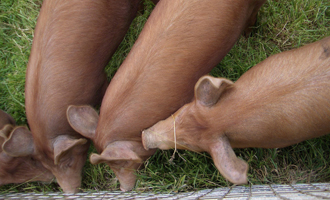WOOSTER, Ohio — Better education regarding the nature of influenza viruses and how to prevent infection, along with stepped up efforts to keep sick pigs away from agricultural fairs, are the best ways to minimize risk of human disease and any potentially adverse impact on the country’s pork industry as a result of the current outbreak of influenza A H3N2 variant virus, Ohio State University animal virologists say.
Cases
According to the latest update from the Centers for Disease Control and Prevention, the H3N2v virus (called “variant” because it has some unique genetic changes compared to typical swine H3N2 viruses), has infected 153 people since July of this year. All but two of these cases occurred in Ohio and Indiana.
As of Aug. 17, the Ohio Department of Health has confirmed 79 cases of influenza A H3N2v statewide.
The majority of those who have contracted the virus had direct contact with pigs, mainly at state or county fairs. Most of the cases have been reported in children.
So far, nobody has died from the H3N2v virus. The severity of illnesses associated with this virus in humans has been similar to the severity of illnesses commonly seen with seasonal flu virus infections, the CDC reported.
“I wouldn’t call the virus responsible for this outbreak ‘swine flu’,” said Mo Saif, head of Ohio State’s Food Animal Health Research Program and a leading animal virologist. “Most swine influenza viruses stay in pigs, and most human influenza viruses infect only humans.
“What we have here is a new influenza virus with elements from various other influenza viruses, and which has been able to move from one species to another.”
Avoiding panic
Saif’s colleague Chang Won Lee, who specializes in the study of influenza viruses and the development of vaccines, agrees. For Lee, raising the level of awareness among the public about how influenza viruses work is crucial to more effectively reducing human illnesses, avoiding panic, and unfairly targeting a particular animal species and the industries associated with it.
“This outbreak is not pandemic flu,” he said. “The H3N2v virus is not being transmitted from human to human. “So far, all instances of disease have involved contact with pigs carrying the virus. This is not like the 2009 H1N1 pandemic flu virus, which is thought to be circulated among humans undetected for a long time and was erroneously called ‘swine flu,’ even though it was never determined that it came from pigs.”
The H3N2v virus, Lee explained, is a combination of genetic material from H3 swine influenza viruses and a gene from the H1N1 pandemic flu virus called the matrix (M) gene. While this M gene does not automatically make the H3N2v virus behave like a pandemic flu virus, it does make it more infectious and prevalent among pigs.
And because the H3N2v virus is sickening more pigs than other swine influenza viruses, it has more chances to infect humans who come into contact with sick animals.
Reasons
Lee said there are three possible reasons explaining why there have been more than 150 human cases reported in the current outbreak, while other swine influenza viruses in the past have only been reported to infect a handful of people.
“First, this virus is more prevalent in swine than previous viruses, and pigs appear to be more susceptible to it possibly due to the M gene from H1N1 pandemic flu virus,” he said. “Also, since 2009, clinicians have been more aware of swine influenza viruses, leading to the increased reporting of cases.
“Finally, I believe that this summer’s extremely hot weather in the Midwest has immunosuppressed many pigs, making them more susceptible to infection, allowing the virus to stay longer in them and increasing the shedding of the virus. This may have increased the chances of transmission to humans.”
Prevention
There are important steps agricultural fairgoers, those tasked with managing fairs, youth showing pigs at fairs and swine producers can do to reduce the impact of the current H3N2v virus outbreak, Saif said.
Those visiting fairs should wash their hands with soap and water before and after going into animal buildings, avoid eating or drinking in those buildings, and avoid contact with animals and barn surfaces. These precautions should be taken anytime people come into contact with any poultry or livestock in any setting, to minimize the risk of any possible infection to humans and also to keep animals safe from human illnesses.
“Kids showing pigs at fairs and their advisers need to be on the lookout for any sign of disease in their animals, including coughing, wheezing, breathing difficulty and fever, and avoid taking any sick animal to fair,” Saif recommended. “Also, it would be a good idea for fair administrators to have a veterinarian check these animals.”
In the case of swine farmers, Saif said, active surveillance is critical to guaranteeing the health of their herds, particularly when highly infectious viruses such as H3N2 are known to be circulating.
“Biosecurity is very important,” he said. “Producers should monitor their animals for disease symptoms and be careful as to who comes into contact with their swine.”
STAY INFORMED. SIGN UP!
Up-to-date agriculture news in your inbox!











